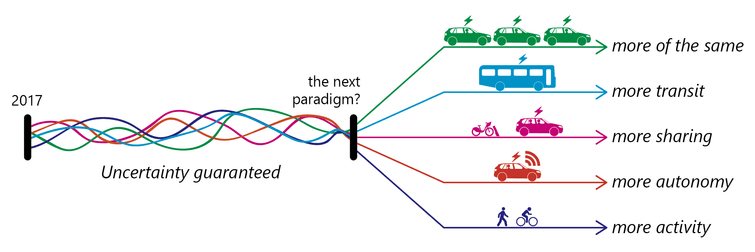
blog: Autonomy: Are 'Friends' Electric?
Thursday 23rd November 2017
How can we separate the way we live our lives, the way we think, the way we move, and what we demand from our cities?
They are all so intrinsically linked that it’s almost impossible to see which one is the driver of change. Undoubtedly we are in the midst of a seismic shift in respect of our demands for mobility and how we express them. This begs several questions; Is user demand driving change? Or technology? Or are we part of a master plan that seeks to define the way we use transport and our cities’ function in the future?
Perhaps worryingly, I genuinely don’t know!
The development of autonomous vehicles is fascinating and, until recently, a concept only of science fiction. However, I do wonder what ‘problems’ this technological development seeks to solve relative to those it may create.
Undoubtedly autonomous vehicles will have a big effect on employment; as taxi drivers, truck drivers, bus drivers, delivery drivers become redundant. Maybe even the need for insurance will disappear as autonomy eliminates human error. There are perhaps positive effects through the reduced need for city centre car parks, as vehicles are either kept on the move or sent back to base when not needed. But should we see these as just vehicles, or will their function change fundamentally? With no need for attention on the journey could the vehicle become a meeting space where there is no longer a need to reach a destination, but instead to pick attendees up and circulate until interactions are complete? The vehicle’s role in providing mobility could readily shift to being a mobile space for any number of purposes, but what then becomes of the static places that get replaced should the journey become the destination?
Removing the need to hold driving skills to travel in a private vehicle will release the benefits associated with this form of mobility to many that are currently denied. A recent Direct Line Insurance survey suggested driverless cars could get 1.2 million people aged over 75 back on the road. Of course, mobility is good - it fuels the economy, supports social objectives, and enhances people’s well-being - but its impacts must be considered and managed.
Higher levels of mobility fuelled by autonomy are not likely to solve the issue of congestion on our roads, nor the competing demands for more road space – particularly in urban areas. Instead we face the prospect of even more metal boxes travelling around. How we view congestion may change as the vehicle becomes usable space, but what happens outside of the vehicle – what will our cities look like and how will they feel – human or mechanistic?
In part the impacts will be guided by patterns of ownership. With increasing affluence there is a desire to use disposable income to assert to the world a sense of achievement, and there is no greater symbol of achievement than a car with an appropriate badge. Whilst there is some movement away from car ownership to car access in many European cities, the trend has been less pronounced in the UK. Even if forces are at work that lead to reductions in vehicle ownership, few are considering the possibility that autonomy might have the opposite impact. The vehicle as a piece of technology where you can watch a movie, browse the internet, shop, prepare drinks and food, could equally increase human desire for ownership.
The beacon of light in reducing our reliance on private vehicle travel, as demonstrated in London by a 25% fall in the share of journeys made by car since 1990, might also be reversed by the advent of autonomy. In 1994 we know that 48% of 17-20 year-olds had driving licences, and data from the National Travel Survey shows that this figure had dropped to 31% in 2016. Reasons for decline were cited as a preference for investment in personal technology and rising insurance costs - both issues that may become less relevant with autonomy.
Of course, as transport planners we know that collective transport offers the most efficient way of moving people around our cities. More demand-responsive public transport could significantly increase this efficiency, and be better attuned to the needs of those travellers influenced more by convenience than cost.
The inconvenient truth appears to be that if we care about our cities as places of human interaction, diversity, and social cohesion; then we must anticipate the potential impacts of autonomy and not permit technology to lead us. Maybe instead it would be better for people to apply exciting technologies to solving the many urban mobility problems we already know about, rather than allowing shiny new machines to drive the evolution of the places we live in?
